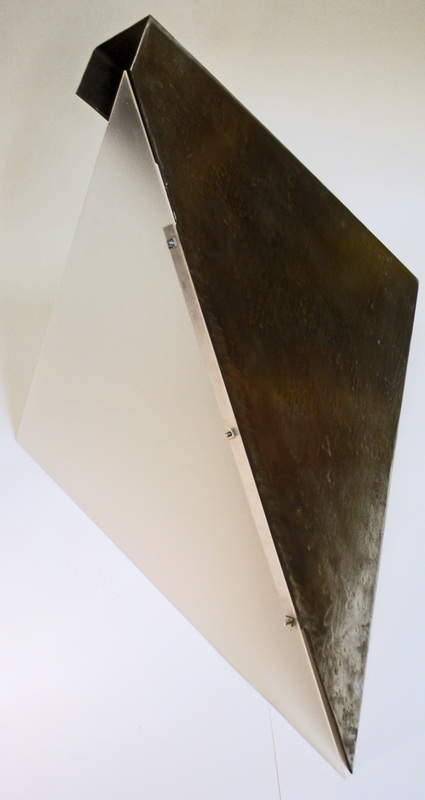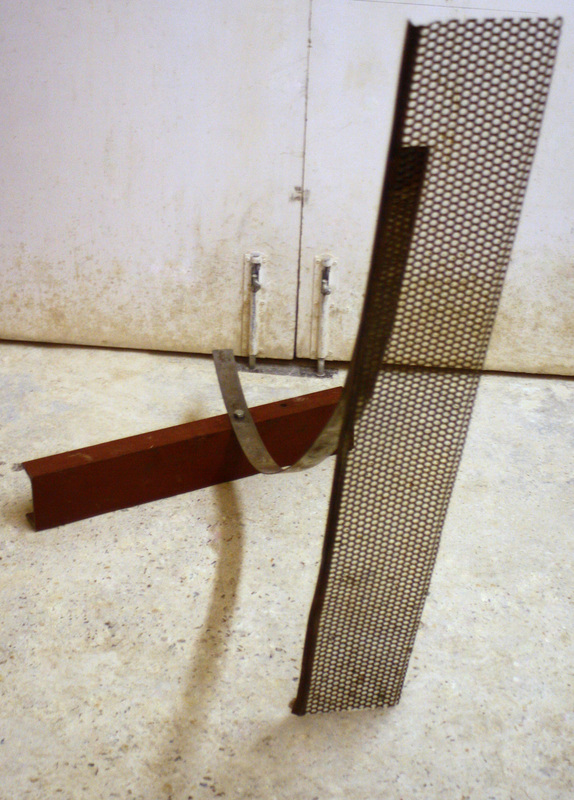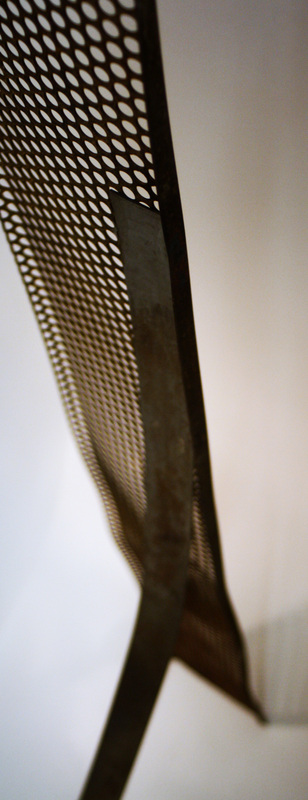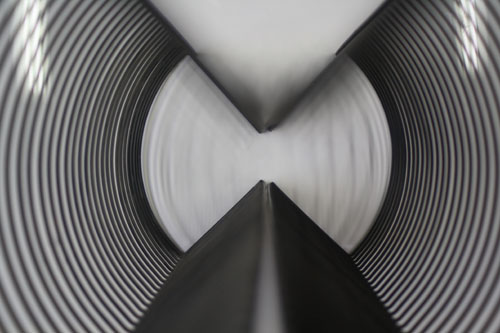I totally agree with you that the pieces could be interesting in how they respond to changing elements within their surrounding environment. For me, I am particularly interested in how the natrual light affects the work as light is fundamental to my work.
I am also interested in what you said about the viewer altering the work. Is that something you address in your work? It is something I look at quite often.
I definetly agree with what you are saying about the space that one works in really pushes the work further and by working in an unusual space other than the gallery space or studio it would really begin to push the work further. Maybe we could be really bold and create the work in situ and during GI itself? We could set a time period and certain constraints and could create a collaborative resonse to the space. This could be really interesting alongside a more planned piece of work brought to the space by each of us.Then the idea of process of making work would really be represented.I like the idea of leaving work to develop. How could we do this? Would we invite contributions from those viewing? Or would the development simply be the natural exposure and weathering of the pieces?
Also, admittedly I can't see the change in the post titles but I think if it is more relevant to the dialogue about the project and working on a site-specific basis then you're right it is more suitable.
Jen
I think because of the nature of both of our work I feel it would benefit from being in a space that has quite a dynamic layout, either structurally or naturally. Both our work is about environment, either the way that people respond to the environment around them or using interventions in a particular environment to create an opening-out of context, so it would be great if it was in a space where we would have something to really grab a hold of and respond to.
Our work being mostly structural it might stand out well if it was placed contrast against a more organic habitat. In your case think that this juxtaposition might lend itself well in emphasising the question of how people feel when they confront a space? While some of my work may be focused on utilizing natural light so because of this it might also work well outdoors.
Access is definitely something to take into consideration, as you said I think it would be interesting if it allows viewers to explore areas where they may not have had a reason to venture to before. Therefore it may be exciting for those who are willing to seek out independent work somewhere interesting off the beaten track. We would have to be careful it is not too hard to reach or easy to miss as we would not want to exclude anyone from the experience of viewing the work. I like the thought that, if the work was exhibited outdoors or somewhere unexpected it might encourage others to create work in any given environ, that anywhere can be used as an exhibition space - there need not be any bounds to spontaneous creative exploration.
I can imagine the work emerging from the undergrowth in somewhere that has perhaps been reclaimed by nature, I think this might give them an ethereal quality. We spoke about the works being ephemeral in nature and I think this might add to that idea?
I also like the idea that if it were left outside where it is open to the elements or others engaging with the work in some way, whether through making the work deliberately interactive or simple by giving viewers the freedom to touch and explore the work, that the process involved in creating the work would not stop when we install it. It would continue on but without us playing a further part in it. As art not simply denoting experience but experiential in itself beyond the act of the viewers or artists' experiece but as part of it's environment and broader context.
Because making art is an experiential process, I think that is part of what makes it interesting is imagining someone spending time and thought on something because they care about it and want to share it with others, as we are doing now. Carrie from The Mutual Collective, who are facilitating the project, mentioned that work in galleries often seemingly appears as if from nowhere and seems to disappear in much the same way. The experience of the viewer is important, but more important I think is the value imbued in sharing the work, and think it is much more natural to view it as a longer experiential process. Leaving the work to continue to develop would emphasise this point so that the process becomes part of the exhibit in itself.
I think working outdoors or in an architecturally dynamic space might create obsitcles that would ecourage us to change our working process, bending them to our environment in more challenging ways while creating our collaborative pieces of work, leading to unexpected and exciting outcomes?
Do you find that working in and responding to spaces has had an unexpected role in the development of you work as a whole, maybe leading you in directions you hadn't previously considered?
Jen
Jen, I felt our blog needed a bit of re titling in order to suggest what we are trying to put across. So I changed the title about site specific works to suggest our dialogue. What do you think?
I have been experimenting with materials and combinations of materials. Thinking about how I can deal with scale and limatations to do with finance, transport and storage space. I have been making smaller works that give illusions of a larger scale or photographic images which become ambiguous in scale. I am particulary enjoying experimenting with different materials and processes, such as carving wood and stone, welding and photography.
I feel this way of making work will become important when I don't have the space to respond to site specifically. These works and experiments become a way of combining different influences and responses to space into smaller pieces and have a different effect on the viewer, rather than making the viewer feel immersed in a space or impacted by the scale of a sculpture, the works suggest proposals for bigger things or make the viewer question the impact of scale.
Susie
So...
We have decided as we are really starting to get into the nitty gritty of planning Void now that we should start a dialogue about the process of planning the works. We both feel that it would be great to give the viewer an insight into this process before they view our work as often this is overlooked or not part of the finished work.
It will be great to have the chance to openly critique our work and to form a discursive collaboration that crosses the distance between us and enables us to share a studio practice from very different geographical locations. We open response from anyone reading this and hope we can engage as much as possible with our audience.
Today Jen and I have been talking about spaces- trying to decide what type of space we would like to aim to work in eventually during GI, so I feel that this could be a good place to start......
For me the space is important, but I feel that I will respond to any space that we choose and the space will inform the type of work I make. If we choose somewhere inside and more white cube like- I would like to show some light installations or photographic work. Whereas if the space is more natural- I would love to contrast the natural setting with something geometric and more material based. Something about weight, gravity and material matter.
I feel that we are both back to our initial thoughts that a space where we can leave the work to be exposed to the elements would be interesting. Somewhere that crosses boundaries of inside/out minimalist and historical, geometric and organic. For me I am particularly interested in a public space that is partly sheltered but has no locked door or inaccessible element. I love the idea of the unexpected and unpredictable. So that people are encouraged to explore and to come across the work in a space they might not expect to find artwork. To me that is what Glasgow International is all about- a chance to explore the city like you wouldn't normally do. To encounter art in unusual spaces or to re visit parts of the city you might not have had reason to go to for some time.
What do you think Jen? How does space inform your work? What are you looking for from a space for this festival?
Susie
I have been looking recently at the patterns of chaos and order evident in natural forms throughout nature. This interest developed as I find it fascinating that such patterns occur both at the smallest and vastest of scales, down to our own molecular make-up, up to the broadest systems of time and space.
Seemingly sporadic, yet intrinsically these patterns contain a uniformity of balance and symmetry. Not only is this physical combination aesthetically exciting but I find it fascinating that the same pattern can be perceived in the metaphysical; in the behavioral systems of nature, from cognitive thought patterns through to the way cities develop and communities form, to the destruction and renewal inherent in all of life and nature.
Perhaps one of the most intriguing physical examples of this is mineral structures, not only do they embody the physical attributes of chaos and order, also I find the way they capture and deflect light captivating. The way they absorb and deflect light could be seen in a similar way to cognitive processes; in absorbing some and putting less consequential information to the side, there are parallels to how we receive others. Previously I have used the redirection of natural light in my practice as a means of opening up the context of a space.
Because of this I plan to experiment with different structures and materials to create a crossover which is representative of the symbiotic nature of the patterns which I have observed, in a way that denotes scientific exploration, using visual notes as reference points to the phenomenon of timeless and spatially unbound synergy.
Jen Argo





 RSS Feed
RSS Feed